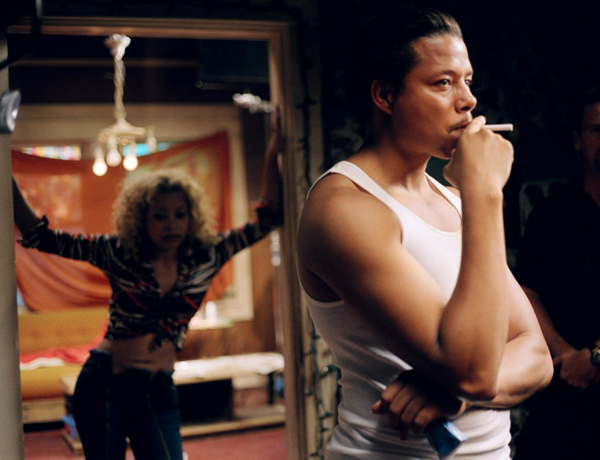Movie review by Greg Carlson
Writer-director Craig Brewer’s “Hustle & Flow” has already been the subject of much discussion regarding its depiction of a Memphis pimp who dreams of hip-hop stardom as a way out of his miserable economic straits. Cinema routinely depicts unsavory anti-heroes and morally compromised protagonists, but the inherent misogyny of pimping makes the possibility of telling a balanced story much more complex than the filmmaker can handle. While “Hustle & Flow” sticks close to its “everybody gotta have a dream” mantra, aping the rags to riches formula that fuels the American desire for success, it remains too timid to explore its central character as anything other than the gold-hearted patriarch of a dysfunctional family.
Terrence Howard, as DJay, is so good in the lead role that one occasionally overlooks the hokey simplicity of the movie’s well-worn formula. Howard brings his character to vivid life, and it is only the film’s writing that fails him. Delivering wise, weary monologues in his beat up whip, DJay’s aspirations to create something bigger than himself extend well beyond the paltry existence he scratches out by exploiting a trio of unfortunate young women. Sharing his innermost thoughts with the hard working Nola (Taryn Manning), DJay makes clear his restless lack of satisfaction, and Howard’s interpretation is magnetic.
A chance encounter with Key (Anthony Anderson), an old high school acquaintance, opens the door for DJay to record some of his own rhymes. Despite the objections of Key’s nervous wife Yevette (Elise Neal), the two men set up shop in DJay’s sweltering house, and begin tinkering with sounds and rhythms. Realizing they need some additional expertise, Key enlists Shelby (DJ Qualls), an enthusiastic church organist who knows his way around samplers and synthesizers, to craft some hooks for the songs. Surprisingly, the trio makes impressive progress in short order, and the audience begins to share in their excitement.
DJay’s women are unfortunately seen by Brewer as a means to an end as opposed to full-fledged creative partners in the pimp’s musical efforts. In one harrowing scene, DJay forces Nola to have sex with a sleazy pawnshop proprietor in exchange for an expensive microphone he needs to record his vocals. Another of DJay’s whores named Shug (Taraji P. Henson) turns out to have the singing voice of an angel, but her fawning dependency on DJay is so overwhelming it flirts with caricature. Henson works wonders as the pregnant Shug, but like most of the film’s characters, is hamstrung by writing that humiliates more than it challenges.
A tour-de-force set piece near the end of the film demonstrates some potent directorial skill, as DJay nervously approaches a successful rapper (played by Ludacris) with his demo tape. It is during this section that Brewer comes the closest to realizing the movie’s potential dramatic impact, and he constructs the scene with a sure-handed sense of escalating tension and dread. For the rest of its running time, however, “Hustle & Flow” careens between authenticity and self-parody so often it never manages to find a consistent personality (it doesn’t help that Brewer buys in to the idea that becoming famous and having ridiculous amounts of money are life’s only worthy goals). The film’s outstanding acting never quite compensates for this, but it comes close.
